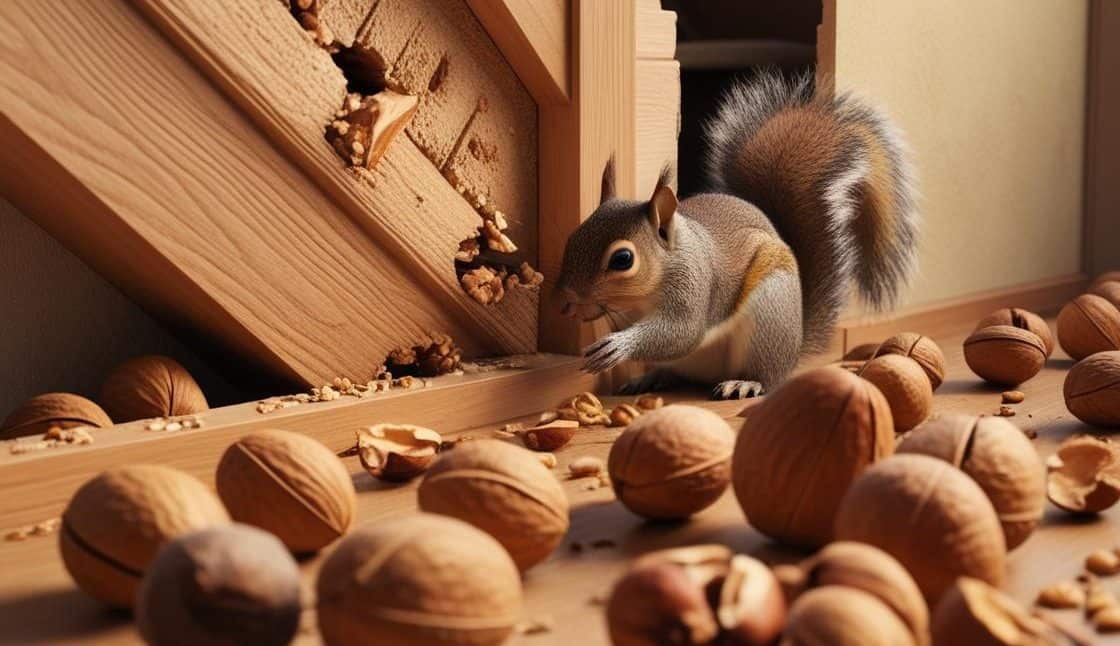
Squirrels, though adorable and energetic in the wild, can be a serious nuisance when they take up residence in your loft or attic. Beyond the rustling noises and occasional glimpses of their bushy tails, squirrel infestations in the home can lead to significant property damage, safety hazards, and health concerns. This guide will explore the clear signs of a squirrel infestation and what steps to take if you find evidence of squirrels in the loft or other areas of your home.
Understanding why squirrels venture into homes is the first step in preventing an infestation. These creatures typically seek out warm, sheltered environments to raise their young and store food. The loft is an ideal location because it offers insulation, darkness, and limited disturbances. In colder months, squirrels are even more likely to seek indoor shelter as they try to escape the elements. Recognising the signs of their presence early can prevent further complications.

Squirrels can be subtle at first, but they inevitably leave signs behind. Here are the top indicators of a squirrel infestation:
One of the earliest and most noticeable signs of a squirrel infestation is the noise they make. If you hear scratching, gnawing, or scurrying sounds, particularly from the loft or attic, this could be a sign of squirrels in the house. These sounds are often more noticeable at dawn and dusk, as squirrels are diurnal creatures, meaning they’re most active during the day.
Sub-Signs to Watch For:
Squirrels are known for their sharp teeth and persistent gnawing behaviour. This can result in significant damage to the structure of your home, particularly in the loft.
Common Areas of Damage:
Squirrel droppings are a common sign of an infestation. They are typically found in lofts, garages, or near entry points. Recognising squirrel droppings can be tricky, as they resemble other rodents’ waste.
Warning: Avoid contact with droppings, as they can carry diseases. If you find droppings, contact a pest control professional for safe removal and identification.
If squirrels become trapped in your loft or wall cavities, they may eventually die, leading to a strong, foul odour. This smell is hard to ignore and usually indicates a serious infestation issue.
Note: Dead animals in the home can attract other pests like flies or scavenging animals, compounding the infestation problem. A pest control professional should handle the removal of dead squirrels.
Squirrels leave behind identifiable tracks. Look for small footprints with four toes on the front paws and five on the back paws. Dusty areas, such as attics, often reveal these tracks clearly. Some homeowners sprinkle flour around suspected areas to confirm the presence of squirrels.
If you store belongings in your loft, check them for damage. Squirrels will chew through cardboard, plastic, fabric, and even metal to gather materials for nesting.
Items Commonly Affected:
An uptick in squirrels around your property can be a precursor to an infestation, as they scout for food and shelter. If you notice squirrels frequently around your roof or yard, particularly in early spring and autumn, be on alert for other infestation signs.
Unlike rodents that can be deterred with traps or poison, squirrels are determined and agile. Their powerful teeth grow continuously, meaning they need to gnaw constantly to keep them sharp. Ignoring the issue can lead to rapid property damage and further invasion, as they find entry points into other areas of the house.
Prevention is the most effective way to avoid dealing with a full-blown infestation. Here are several ways to protect your home:
Inspect your home’s exterior, particularly around the roofline, vents, chimneys, and eaves. Seal any openings larger than half an inch with metal mesh or steel wool, which squirrels cannot chew through.
Squirrels often use branches as pathways to rooftops. Keeping trees trimmed reduces their access.
Squirrels are opportunistic eaters. Ensure any food, including pet food, is stored in airtight containers. This applies to bird feeders, too; consider squirrel-proof feeders if they are attracting squirrels to your property.
Keep your loft and garden tidy, as clutter provides hiding and nesting spots. Regularly inspect your loft for any signs of nesting materials and droppings.
Consider pest control services specialising in humane squirrel removal and prevention methods. They can inspect your property for vulnerabilities and provide guidance on keeping it squirrel-free.
If you confirm an infestation, here’s how to address it:
Professional pest control companies offer humane and effective removal methods. They are also equipped to clean and sanitise areas affected by squirrel droppings and nesting materials.
Experts like Pest Dominion provide comprehensive pest control services in Slough, ensuring thorough and eco-friendly removal methods. Our services not only address the immediate issue but also include cleaning and sanitising areas affected by squirrel droppings and nesting materials. As a BPCA-registered and TrustMark-accredited company, we adhere to the highest industry standards, so you can be confident in their safe and sustainable approach.
After removal, it’s essential to implement long-term exclusion measures. This might involve installing metal flashing, using squirrel-proof bird feeders, and regular inspections to detect signs of reinfestation.
Spotting the signs of a squirrel infestation early is key to avoiding costly repairs and ensuring your home remains a safe environment. With regular inspections, preventive measures, and professional assistance when needed, you can keep squirrels at bay. By staying vigilant and taking immediate action at the first signs of infestation, you can protect your loft and the rest of your home from these unexpected guests.